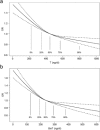Low Testosterone, but Not Estradiol, Is Associated With Incident Falls in Older Men: The International MrOS Study
- PMID: 28135013
- PMCID: PMC5466469
- DOI: 10.1002/jbmr.3088
Low Testosterone, but Not Estradiol, Is Associated With Incident Falls in Older Men: The International MrOS Study
Abstract
Fracture risk is determined by bone strength and the risk of falls. The relationship between serum sex steroids and bone strength parameters in men is well known, whereas the predictive value of sex steroids for falls is less studied. The aim of this study was to assess the associations between serum testosterone (T) and estradiol (E2) and the likelihood of falls. Older men (aged ≥65 years) from the United States (n = 1919), Sweden (n = 2495), and Hong Kong (n = 1469) participating in the Osteoporotic Fractures in Men Study had baseline T and E2 analyzed by mass spectrometry. Bioavailable (Bio) levels were calculated using mass action equations. Incident falls were ascertained every 4 months during a mean follow-up of 5.7 years. Associations between sex steroids and falls were estimated by generalized estimating equations. Fall rate was highest in the US and lowest in Hong Kong (US 0.50, Sweden 0.31, Hong Kong 0.12 fall reports/person/year). In the combined cohort of 5883 men, total T (odds ratio [OR] per SD increase = 0.88, 95% confidence interval [CI] 0.86-0.91) and BioT (OR = 0.86, 95% CI 0.83-0.88) were associated with incident falls in models adjusted for age and prevalent falls. These associations were only slightly attenuated after simultaneous adjustment for physical performance variables (total T: OR = 0.94, 95% CI 0.91-0.96; BioT: OR = 0.91, 95% CI 0.89-0.94). E2, BioE2, and sex hormone-binding globulin (SHBG) were not significantly associated with falls. Analyses in the individual cohorts showed that both total T and BioT were associated with falls in MrOS US and Sweden. No association was found in MrOS Hong Kong, and this may be attributable to environmental factors rather than ethnic differences because total T and BioT predicted falls in MrOS US Asians. In conclusion, low total T and BioT levels, but not E2 or SHBG, are associated with increased falls in older men. © 2017 American Society for Bone and Mineral Research.
Keywords: FALLS; GENERAL POPULATION STUDIES; MEN; PHYSICAL PERFORMANCE; SEX STEROIDS.
© 2017 American Society for Bone and Mineral Research.
Figures

Similar articles
-
The Limited Clinical Utility of Testosterone, Estradiol, and Sex Hormone Binding Globulin Measurements in the Prediction of Fracture Risk and Bone Loss in Older Men.J Bone Miner Res. 2017 Mar;32(3):633-640. doi: 10.1002/jbmr.3021. Epub 2016 Nov 14. J Bone Miner Res. 2017. PMID: 27753150 Free PMC article.
-
High Serum SHBG Predicts Incident Vertebral Fractures in Elderly Men.J Bone Miner Res. 2016 Mar;31(3):683-9. doi: 10.1002/jbmr.2718. Epub 2016 Jan 20. J Bone Miner Res. 2016. PMID: 26391196 Free PMC article.
-
The effects of serum testosterone, estradiol, and sex hormone binding globulin levels on fracture risk in older men.J Clin Endocrinol Metab. 2009 Sep;94(9):3337-46. doi: 10.1210/jc.2009-0206. Epub 2009 Jul 7. J Clin Endocrinol Metab. 2009. PMID: 19584177 Free PMC article.
-
Serum DHEA and Its Sulfate Are Associated With Incident Fall Risk in Older Men: The MrOS Sweden Study.J Bone Miner Res. 2018 Jul;33(7):1227-1232. doi: 10.1002/jbmr.3418. Epub 2018 Apr 10. J Bone Miner Res. 2018. PMID: 29528519
-
'Healthier Chinese spine': an update of osteoporotic fractures in men (MrOS) and in women (MsOS) Hong Kong spine radiograph studies.Quant Imaging Med Surg. 2022 Mar;12(3):2090-2105. doi: 10.21037/qims-2021-07. Quant Imaging Med Surg. 2022. PMID: 35284274 Free PMC article. Review.
Cited by
-
Beneficial effects of exercise, testosterone, vitamin D, calcium and protein in older men-A randomized clinical trial.J Cachexia Sarcopenia Muscle. 2024 Aug;15(4):1451-1462. doi: 10.1002/jcsm.13498. Epub 2024 Jun 18. J Cachexia Sarcopenia Muscle. 2024. PMID: 38890228 Free PMC article. Clinical Trial.
-
Prognostic significance of frailty in older patients with hip fracture: a systematic review and meta-analysis.Int Orthop. 2022 Dec;46(12):2939-2952. doi: 10.1007/s00264-022-05605-9. Epub 2022 Oct 13. Int Orthop. 2022. PMID: 36227383
-
Management of osteoporosis in older men.Aging Clin Exp Res. 2021 Jun;33(6):1439-1452. doi: 10.1007/s40520-021-01845-8. Epub 2021 Apr 5. Aging Clin Exp Res. 2021. PMID: 33821467 Review.
-
Therapist-Assisted Progressive Resistance Training, Protein Supplements, and Testosterone Injections in Frail Older Men with Testosterone Deficiency: Protocol for a Randomized Placebo-Controlled Trial.JMIR Res Protoc. 2018 Mar 2;7(3):e71. doi: 10.2196/resprot.8854. JMIR Res Protoc. 2018. PMID: 29500160 Free PMC article.
-
High Luteinizing Hormone and Lower Levels of Sex Hormones in Younger Men With Distal Radius Fracture.JBMR Plus. 2020 Nov 2;4(11):e10421. doi: 10.1002/jbm4.10421. eCollection 2020 Nov. JBMR Plus. 2020. PMID: 33210067 Free PMC article.
References
-
- Stevens JA, Mack KA, Paulozzi LJ, Ballesteros MF. Self‐reported falls and fall‐related injuries among persons aged > or = 65 years—United States, 2006. J Safety Res. 2008; 39(3):345–9. - PubMed
-
- Masud T, Morris RO. Epidemiology of falls. Age Ageing. 2001; 30 Suppl 4:3–7. - PubMed
-
- Kaufman JM, Vermeulen A. The decline of androgen levels in elderly men and its clinical and therapeutic implications. Endocr Rev. 2005; 26(6):833–76. - PubMed
-
- Orwoll E, Lambert LC, Marshall LM, et al. Testosterone and estradiol among older men. J Clin Endocrinol Metab. 2006; 91(4):1336–44. - PubMed
MeSH terms
Substances
Grants and funding
LinkOut - more resources
Full Text Sources
Other Literature Sources
Medical
Miscellaneous

